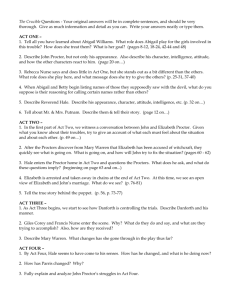

“Traditionally, ‘The Crucible’ is a very minimal show in the way of sets and costumes.”įor example, one artistic lighting choice made by the students was to create the feeling of a home or a jail cell using lighting techniques, such as utilizing the light mover to form different visual impacts.



“The design choices are special because for the most part they were chosen by the students,” Kirby said. “ is interesting because it is really about the dark side of Salem, and it is about the side we never really hear about society,” Pagador said.Īs a collaborative effort by sophomores and freshmen from drama and stage technician classes, all students involved were given the chance to see how a high school play evolves into a full-scale production. “Although many people think Salem was a boring time, and it’s just another lesson in history, actually had some stories behind it with all these young girls and the adults actually thought the Devil is real,” said freshman Kayla Espiritu who plays Abigail Williams, one of the main accusers.Īshley Pagador, the actor playing Elizabeth Proctor who was accused by Abigail Williams of practicing witchcraft, shared a similar appreciation for the play’s varied messages. The controversial theme of “The Crucible” has fascinated many cast members. “After talking to the English Department and learning they will be using as one of their studies in American literature…we thought it would be a really cool cross collaboration between the English Department and the Visual and Performing Arts Department,” director and drama teacher Megan Kirby said. S ophomores studied “The Crucible” in their American Literature classes, which was taken into consideration when choosing the first official fall play. “The Crucible” began with young girls’ accusations of witchcraft and eventually led to a tragic ending with many lives being needlessly lost. 16-18 as drama students recalled the injustices surrounding the infamous witch trials in their performance of Arthur Miller’s classic play, “The Crucible.” Miller explored how paranoia clouds people’s judgments through his fictional take on the 1692 witch trials in Salem, Massachusetts. The grievances of innocent spirits from Salem echoed throughout the theater on Nov.


 0 kommentar(er)
0 kommentar(er)
